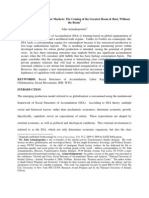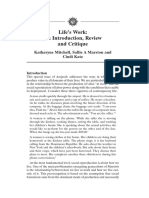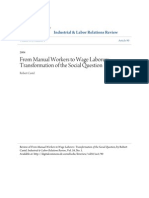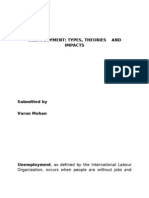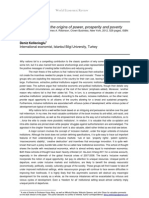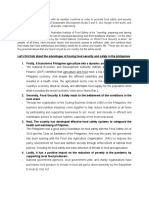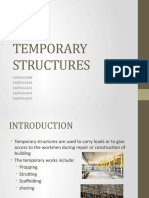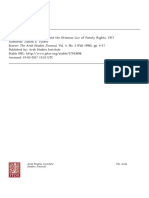Castells Portes The World Underneath
Castells Portes The World Underneath
Uploaded by
Maria Carrizosa BermudezCopyright:
Available Formats
Castells Portes The World Underneath
Castells Portes The World Underneath
Uploaded by
Maria Carrizosa BermudezOriginal Title
Copyright
Available Formats
Share this document
Did you find this document useful?
Is this content inappropriate?
Copyright:
Available Formats
Castells Portes The World Underneath
Castells Portes The World Underneath
Uploaded by
Maria Carrizosa BermudezCopyright:
Available Formats
,
I
I
t
,
Alejc;1'\dl-O Potlt.s (eel.). The. r,..fe>t'l'1'dl Eco"l'lo'm) 5i \1 d ie ')
1"11 o..d'IC'o'l1reJ o.'nd, less df\Je\0f'tcl COO..,,;r; e S .
B""lt: /"'lei.
Jel-l-ns
fS!> J
"
("" 1.:21)
x;
1 World Underneath: The Origins,
Dynamics, and Effects of the
Informal Economy
Manuel Castells and Alelandro Portes
History is full of Whenever a social fact is believed to be a
secular trend, experience reverses it eventually. The 'growth of the infonnal
economy in different social and economic contexts over the last decade ex
emplifies this crucial feature of human society. In many contexts self-em
ployment is growing more rapidly than salaried employment. The process of
institutionalization of economic activities is slowing down. Horizontal net
works, not vertical bureaucracies, seem to be the new models of efficient
organizations. Subcontracting prevails over union contracts in various indus- '
trial sectors. The cash economy is expanding in the microeconomic' realm,
while barter is becoming a crucial feature of international exchange. New
legions of would-be workers are entering a casual iabor market, .where a new
breed of entrepreneurship is on the make. The informal economy 'simul
taneously encompasses flexibility and exploitation, productivity and abuse,
aggressive entrepreneurs and defenseless workers, libertarianism and greed
iness..\oct, above all, there is disenfranchisement of the institutionalized.
power conquered by labor, with much suffering, in a twC'-Century-ol<;f struggle.,
As with all fundamental social debates, the noise of ideology.blurs the
profile of the thus confusing potential answel:'S. In this chapter. we
anempt to outline the principal issues under discussion cor:cerning the informal
economy, thus opening the way for their clarification by research conducted in
diverse social settings. Our position on these issues does not always agree with
those of other authors. However, there is a universe of common concerns
addressed by studies of the infonnal economy throughout the world. OU! '
purpose here is to highlight what these concerns are and offer a general perspec
tive on them as a point of reference for the evaluation of the manifold variants
uncovered by empirical inquiries.
What Is the Informal Economy?
The infonnal economy is a cornmon-sense notion whose moving social bound
cannot be captured by a strict definition without closing the debate pre
maturely. This is why we need, first, to refer to the historicaI realities
by the theme, and to understand it as a process, rather than as an object.
.&
II
In any tentative approach to a confusing and yet significant reality, it is
always useful to determine what it is not, in spite of the images evoked by the
notion in our collective consciousness. The informal economy is not a set of
survival activities performed by destitute people on the margins of society.
Studies in both advanced industrial and less developed countries have shown
the economic dynamism of unregulated income generating activities and the
relatively high level of income of many informal entrepreneurs, sometimes
above the level of workers in the formal economy (Lozano 1985; Ferman,
Berndt, and Selo 1978; Henry 1978; Portes, Blitzer, and Curtis 1986). Some
activities in the informal sector may derive from .he desperate need of a worker
to obtain the means of subsistence for his or her family. But a similar motivation
could lead a worker to accept lower wages in the formal sector. The informal
economy is not a euphemism for poverty. It is a specific form of relationships of
production, while poverty is an attribute linked to the process of distribution.
At first sight, it would seem inappr9priate to use the same concept to
embrace such different situations as those of a street seller in Latin America and
a software consultant moonlighting in Silicon Valley. And ye!, it is precisely
because we refer to a specific form of income-generating production rela
tionships that the concept of the informal economy is useful. Thus, we depart
from the notions of economic dualism and social marginality which have been
so pervasive in the development literature in !'pite of all empirical evidence
accumulated against such notions (see Perlman 1976; Moser 1978).
Although most of the individuals engaged in informal economic ac
tivities are poor, particularly in the Third World, informal economic processes
cut across the whole social structure. By focusing on the logic of the process, it
is possible to look behind the appearance of social conditions (poverty, destitu
tion, blight) to focus on the social dynamics underlying the production of such
conditions. Hence, while we do not negate the of poverty studies,
our interest here is on the analysis of a different subject: the redefinition of
production relationships through the articulation of formal and informal
activities.
There is strong evidence of the systematic linkage between formal and
informal sectors, following the of profitability (Birbeck 1979;
Brusco 1982; Roberts, this volume). Individual workers may switch between
the two sectors even during the same workday, with a unionized machinist
moonlighting as a plumber while a secretary does keypunching at home in her
off-duty time (Gershuny 1978; Saba 1980; Mingione 1983). The informal
economy is thus not an individual condition but a process of income-generation
characterized by one centrai'feature: it is unregulated by the institutions of
society. in a legal and social environment in which similar activities are
regulated.
Any change in the institutional boundaries of regulation of economic
activities produces a parallel realignment of the foanal-informal relationship.
Overview
In fact, it is because there i!' a fonnal economy (Le., an institutional fratnewQrk
of economic activity) that we can speak of an "informal" one. In an ideal
market economy, with no regulation of any kind, the distinction between
formal a.,d infonnal would lose meaning since all activities would be per
fonned in the manner we now caB informal. At the opposite pole, the more a
society institutionalize!' its economic activities following collectively defined
).lOwer relationships and the more individual actors try to escape this institu-
rionalized logic, the sharper the divide between the two sectors.
What is new in the current context is that the infonnal sector grows,
even in highl) institutionalized economies, at the. expense of already for
malized work relationships (Tanzi 1982; Tokman 1986; Sassen-Koob, this
volume). Thus, it represents a novel social trend instead of being a mere ."lag"
from traditional relationships of production. When a modem paper-producing.
mill in Cali, Colombia, subcontracts the. work of providing raw materials to
garbage-pickers, this phenomenon cannot be explained as the persistence of
survival activities among the urban poor, but rather as a disguised fonn of wage
labor which deprives workers even of the meaning of a proletarian workrela
tionship (Birbeck 1979; furtuna and Prates, this volume).
Furthermore, it is the expansion of infonnal activities in a largely
regulated context that gives a new historical meaning to the current process of a
rising informal economy. It is often argued that uncontrolled, exploitative
rel..tionships of production are the oldest story, so that sweatshops represent
dassical capitalism, not advanced capitalism. But it' is precisely the develop
ment of sweatshops and of other unregulated activities after a long period of
institutional control that causes old forms of production to become new ones.
An old form in a new setting is, in fact, new, since all social relationships can
oilly be defined in their specific historical context. This context is. defined by the
prior of institutionalized regulation, by which we understand the
explicit, active intervention of the state in the process and outcome of income
g('nerating activities, on the basis of a set of enforceable legal rules.
The absence of institutional regulation in the informal economy may
affect various elements of the work process, since each specific situation de
fines a very distincti ve type of activity. It may refer, first of all, to the status of
labor; for instance, labor may be undeclared. lacking the social benefits to
which it is entitled, paid under the minimum wage, or employed under circum
stances that society's norms would not otherwise allow. It may refer, second, to
the conditions of work under which labor is employed. These may involve, for
instance, :ampering with health conditions, public hygiene, safety hazards, or
the location of aCll vittes, such as ignoring land-use zoning or placing hazardous
manufacturing in the midst of densely populated areas. Third, it may refer to the
particular form of management of some firms. fur instance, a 'company may'
e.1gage in systematic fiscal fraud or the generalized use of unrecorded cash
payments as a means of economic transaction. There is no theoretical reason to
World Underneath
/2
13
T = Licit
- =Illicit
Jrocess of Production
final Economy
md Distribution
Product Type
+
+ Formal
+ Informol
+ or - Criminal
C
D
A
B
Criminal
Informal
A State interference, competition from large firms, sources of capitol and techrology
B Cheaper consumer goods and industrial inputs, flexible reserves of labor
C State interference and disruption, supplies of certain controlled goods
D Corruption, "gatekeeper's rents" for selected state officials'
I E Capitol, dt.mand for goo<;l,s, new income-earning opportunities
goods, flexible reserves of labor
, See Blanes. this volume; Grossman, this volume
Figure /./. Types of economic activity: /. definitions; II. relationships.
exclude from the info1TIlal economy the unrecorded practices of large corpora
tions, particularly since they have close linkages with the growth of other
informal activities. From tI-.is perspective, the informal economy 'is not a mar
ginal phenomenon for charitable social resean:h, but a politico-.
economic process .It the core of many societies,
Finally, some economic activities may be termed informal because of
their very nature, namely, because they are defined as criminal by the institu
tions of society. Sociologists know, however, that normal/abnormal and
legal/criminal are social categories SUbject to change. when the laws concern
ing thew. are enforced, such categories often represent sources of economic
opportunity outside the pale of institutional regulation. Criminal .activities
possess. however, distinct characteristics that set them apart from those other-
wise termed informal. Figure I. I attempts to clarify the situation by wrtraying
the relationships between different types of income-eaming activities. Those
labeled "Criminal" specialize in the production of goods and services socially
defined as illicit.
On the other hand, the basic distinction between formal and informal'
il;tivities proper does not hinge on the character of the final product, bUI on the
manner in which it is produced and exchanged. Thus, articles of clothing,
restaurant food, or automobile parts-all perfectly licit commodities-may
have their origins in legally regulated or unregulated production arrangements.
By distingubhing these different activities rather than combining them into an
undifferentiated whole, it is possible to examine their interrelationships in
different contexts. Blanes (tUs volume) analyzes, for example, the influence of
tile Bolivian drug economy on that country's formal and informal sectors.
Other possible influences between these different sectors are iIlustrated in figure
1.1.
The rest of this chapter focuses on informal activities proper, that is.
the unregulated production of otherwise licit goods and services. A central
reason for this choice is that these activities, not those conventionally labeled
criminal, represent a novel economic trend. As stated above, this novelty lies in
the resilience or growth of informal arrangements in contexts in which they .
were believed to be extinct or in which they were expected to disappear with the
advance of industrialization. The following section summarizes evidence of
this global trend. .'
The Reality of the Informal Economy:
A Comparative Perspedlve
The most significant generalizations to be drawn from the existing evidence'
are, first, that the informal economy is universal. as similar arrangements are
found in countries and regions at very different levels of economic dev.elop
ment; second, that this sector is heterogeneous, as the forms adopted by unreg
lVorld Underneath /5
14
.&
ulated production and distribution vary; widely even within single societies;
and, third, that there has been an increase of these activities during the
last several years.' '
The evidence for Latin America and other Third World regions
familiar and has been reviewed elsewhere (Tokman 1986, 1982;
Bromley 1978; PREALC 1981; Portes and Benton 1984). During the post
World War II period and until 1980, Latin America experienced a rapid and
sustained process of industrial development. Table 1.1 contains the relt:vant
empirical evidence for the seven largest Latin American countries, three metro
politan areas, and the region as a whole. Although these data from
limitations, discussed below, the pattern that they illustrate is unmistakable.
Between 1950 and 1980, Latin American economies grew at a weight
ed average of 5.5 percent. As shown in table 1.1, the regional GNP quadrupled
during this period. Without exception, individual countries more than doubkd
their gross national products, although rates of growth were much higher in
countries like Colombia, Mexico, and Brazil. Because of rapid population
growth, GNP per capita did not grow as fast, but in 1980 it stood at aplJrox
imately 200 percent of the 1950 figure. The most dynamic element in the
growth of this region was, without doubt, the industrial sector. Industry's share
of the gross domestic product (GDP) registered an unweighted average annual
increase of 6 percent between 1950 and 1975, being much higher in Brazil,
Mexico, Peru, and other countries:
The response of labor marketsi to this accelerated process of indus
trialization was not what orthodox economic theories of industrial development
would have predicted (see Lewis 1959; Garcia 1982). Informal employment, as
defined by the United Nations' Regional Employment Program for Latin P.mer
ica (PREALC), declined. only from 46 percent to 42 percent of the Latin
American labor force (see table 1.1). In 1950, informal activities 30
percent of the urban economically active population (EAP); in 1980, with an
industrial plant four times larger, informal employment still stood at 30 percent.
Contrary to the experience of the advanced countries, self-er.1ployment did not
decline with industrialization but remained essentially constant during this
thirty-year period.
2
At this point, it is useful to compare the experience of Latin American
countries between 1950 and 1980 with that of the United States at the tum of the
century. The two periods are similar in terms of several macroeconomic indica
tors that point to comparable levels of industrial development (Tokman 1982).
Table 1.2 presents data on the relative size of the informal sector in I,atin
America and the Unitt-d Stares during the relevant periods. Not surprisingly, the
proportion of informal workers is seen to decline monotonically in the United
States. The trend is, after all, one of the tmpirical underpinnings of the theory
of labor absorption under rapid industrial growth. In Latin America, on the
other hand, rapid industrial growth during the 1950-80 period led only to a
Informal Workers:
Urban EAp2
Self-employed
3
City/Country Year GNP' ('1 ('1
Argentina 1950 12.9 21.1 22.8 7.8
1980 31.3 23.0 25.7 16.7
Brazil 1950 10.0 27.3 48.3 28.6 .
1980 59.2 27.2 44.5 33.7
Chile 1950 3.4 35.1 31.0 . 22.4
198') 7.7 27.1 18:6
Colombia 195J 2.5 39.0 48.3 23.4
1980 9.5 34.4 41.0 18.9
Mexico 1950 10.0 37.4 56.9 37.4
1980 44.2 35.8 40.4 23.2
Peru 1950 2.2 46.9 56.3
1980 8.3 40.5 55.8 40.2
Venezuela 1950 2.4 32.1 38.9 28.8
1980 8.3 20.8 31.5 31.8 .
BogotA 1975 33.0
(60.5)"
1984 34.2
(59.7)
Montevi<leo 1968 12.5
1983 16.2
Sao Paulo 1976 29.7
6
1982 34.4
Latin America .950 51.8 30.8 46.5 27.3
1980 190.9 30.3 42.2' 28.3
.(60.3)7
Sources: Fcrfa 1984. 136; Lopez Castaiio 1984, 149; Pones 1985, 22-23; Prares 1984. 557;
PREALC 1982. tables 1-3.4.8.9. 19.23.24,33,34,62.63,77,78.96. and 97; Statistical
Department of Colombia 1984, table 6; Statistical A.bsfTQclS 0/ LAtin A._rica 1978, tables 220Q
and 2201. .
IGross national product in billions of 1970 dollars, 1950-1976.
lCountry and !hose for Latin America are the sum of unpaid family woders, domestic
'ervanlS, and the self-employed. minus professionals and technicians.
3When figures for 1930 were unavailable, !hose for 1970 were used.
4Column figures for Bog(,[4 are the sum of the categories in fIO(e 2. Figures in parentheses are the
percentage of workers not registered wi!h the national social security
figures for Montevideo arc the sum of unpaid family workers and !he self-employe<l.
minus professionals and technicians. The figure in parentheses includes lhese categories plus
wage workers without social security protection for a sample reprcsentationof approximately
6'.4% of the city's population.
6Figures for Sao Paulo ove percentages of "irregular" workers. defined as !hose receiving less
than the legal minimum wage per labor hour.
7Figure in parentheses is the sum of the categories in note 2. plus the estimated proportion of
iniormal wage workers.
16 Overview
World Underneath 17
- - -
marginal decline in the size of the informal labor force. Simila; conclusions are
reached when one considers the category of the self-employed alone-com
posed, to a large extent, of itinerant odd-jobbers ana petty artisans. This catego
ry all but disappeared in the industrial sector of the United States during the
period of accelerated growth; in Latin America, it remained a stable one-fifth of
the industrial labor force (see table 1.2).
There is reason to believe, furthermore, that declines in informal
employment, minimal for the region as a whole but significant for a few
countries like Mexico and Venezuela, reflect an over-optimistic assessment of
actual trends. International agencies, which are the source of these data, have
defined informal employment as the sum of the self-employed-excluding
professionals and technicians, unremunerated family workers, and domesti;:
servants. Excluded also are informal wage workers, thai is, those hired casually
and who lack social security protection. According to this definition, thenJore,
all wage workers are part of the formal sector. In Latin America, perhaps with
the exception of Argentina and Uruguay, this assumption leads to a gross
underestimate of informal employment, since a large proportion of wage la
borers are employed in microenterprises that are legally exempted from the
existing labor legislation or simply do not observe it.
The figures in table 1.1 indicate the likely size of this underestimate.
In Bogota, for example, informal workers according to the PREALC definition
represented about a third of the urban labor force in 1984, the figure being
essentially the same as ten years earlier. An alternative and more appropriate
definition, based on labor excluded fropt social security coverage, increases
these estimates significantly to about of the urban EAP in both years. 3 In
general, whenever unprotected wage workers are added to the definition of
informal employment, the relative size of the latter increases significantly. As
shown in table 1. I, this corrected definition leads to a revised estimate of total
informal employment in Latin America which exceeds the PREALC figure by
approximately 20 percent.
Until a few years ago, the bulk of research on the question of infor
mality was conducted in the Third World because most scholars concluded, on
the basis of data such as those in table'l .2, that these arrangements had become
extinct in the advanced countries. Thus, the existence of "invented" jobs in the
interstices of the modem economy was regarded as a typical reflec:ion of the
plight of the poorer countries (Bairoch 1973; Chaney (979). Labor market
analysts in the United States have also suggested that small-scale enterprises
and, in particular, those that, bypass official regulation, either do not exist or are
too insignificant to merit study.
4
Recent research suggests, however, that this neat division between
Third World countries, where the informal sector is large, and advancerl ones,
where it has nearly disappeared, is wrong. On the contrary, informal an'ange
ments seem to be growing rapidly, at least in some sectors. Research on the
Overview
-J I'" 0 os
y-NNN -:;'1:
L2
::: cd: - c
U E ...;:
B en
j
.. t- sa
j ......... :::::J
j
.!!..:! E
c U .... :<0
.. EBB
E
_
c
.;:
"
"
c "
"
.: !Ii:
"0
"
"E.
E
,. ..:. "
u
"I
I!I
'"
'"
N
]
"0
'c
.2 _ 0 t""") -
;:l
....
--
..:.
Jl
id
'"
0_ 'iii "
ci'i
:=t]i
..
]
c I E
1, ;:l
1..=
.s
"0
c
" " '" '" '"
>- ---
"
"
E c
.;:
<
:
u"
J
"
::
J
- "' ....
.: !Ii: N""':ci
-'" " Nt'" N
&
"E
.2
"0
"
'" o
:::
t
u
u .;:
..:. u
Jl
u E
N
'" <
"g .5
<'\-<'\
c
'"
"
1Il
.g
.g
]
"
i
-t!
u
o
:;.
's
..:!
1l
E
u
c
::>
c
l
::>
0..
E
..:.
u
11
.< .s
'0
< E
'" ::>
.!t ""
.s
ci. '"
a:: "
- "?
- !
'5 lo:
.8 "
ii
'i E
.. U
:is 0
!! :t
.. -; ...
E .8
tIJ '0 '0
g:
". = ca ::u
" c c C
lr..l U U U
S
- N l"";
19
18
topic in the United States is more difficult because these activities, clandestine
by definition, are more actively persecuted. The first stab at the problem was
taken by labor economists whose approach was to estimate the magnitude of
"underground" activities on the basis of discrepancies between aggregate mon
etary indkators. The underlying assumption is that infonnal transactions take
place in cash.
Gutmann _(1979), for example, estimated the size of the infonnal
economy by comparing the ratio of outstanding currency to demand deposits in
1978 with the average for the years 1937-41, a period when underground
activities were assumed to be close to Increases in the ratio were imputed
to growth in these activities. On the of this method, Gutmann estimateG
that the infonnal economy represented about 10 percent of the currently mea
sured Gross National Product, or $177 billion, in 1978. Tbis approach has been
employed with variations by other authors. Spitznas (1981) applied Gutmann's
fonnula to the Second Federal Reserve District, which includes New York City.
and estimated the city's underground economy at $16. 2 billion in 1978. He <lIso
estimated that these activities had been growing rapidly.
Although useful as preliminary indicators of the existence of a pre
viously neglected phenomenon, these indirect methods are flawed in several
ways. First, there are no data to demonstrate that infonnal activities were really
zero in selected base years or that informal goods and services are paid for
exclusively in cash. Second, these estimates do not provide any clue as to the
nature of growth in the "unobserved" economy, the industries in which it is
concentrated, or the proportion of the labor force which it empioys. Finally,
despite the similarity of method, economic estimates vary wildly, raising se
rious doubts as to their validity. fur example, Gutmann calculated that these
activities represented about 10 percent of measured GNP in 1978; another
analyst increased that figure to 33 percent (Feige 1979); \' -hile a third reduced it
drasticalIy to 4.4 percent (Tanzi 1980, 1982).
To overcome limitations of the macroeconomic approach, other social
scientists have started to engage in firsthand field research. Results of sl:ch
studies in three U. S. metropolitan areaS are presented in this volume (see the
chapters by Fernandez-Kelly and Garcia; Sassen-Koob; and Stepick). Their
findings are supplemented below with data on the evolution of very sma11
establishments (VSEs), defined as 'those employing less than ten workers.
VSEs are relevant to the question of infonnality for two reasons. First,
by reason of their low visibility, ease of displacement, and other factors, VSEs
provide the most appropriate setting for casual hiring, unreporting of income,
and other informal practices. Direct observational studies indicate that although
many smalI concerns forced to obtain licenses (and thus appear in the
aggregate statistics), their labor practices are mostly informal. Second, VSEs
are easier to convert into totally underground enterprises. While it is generaily
difficult to informalize a plant employing hundreds of workers, this is not the
case for one with only a few employees. Such a firm can close down "offi
cialIy" one day and reopen the next as an underground concern (Lozano 1985:
Green 1983; Siegel and Markoff 1985; Sassen-Koob 1984).
The statistical series in tables 1.3 and 1.4 are drawn from the Census
Bureau's County Business Patterns for various years. As an estimate of the size
of the American informal sector, these data are subject to two opposite biases:
first, not all VSEs engage in informal practices, which leads to an overestimate:
second, fully informal enterprises escape government record keeping, which
leads to the opposite. In this situation, the series are best interpreted as a rough
estimate of the evolution of the informal sector, on the basis of those recorded
firms that most closely approximate it.
Table 1.3 contains the proportion of VSEs and of their employ.ees in
the country as a whole during the period 1965-83. Also included are the
proportion of these units and their employees ih the states of New York;
Califorr.ia, and Florida and of establishments in Queens, Dade (Miami), and
San Diego counties. The latter series corresponds to the sites of recent field
studies, including those reported in this 'volume. Number of employees per
size-class of enterprise is not available in the county series..
About three-fourths of U.S. establishments counted by the census
were VSEs in 1965, and they absorbed approximately one-seventh 'of the
economicaIly active population (EAP). Twenty years later, the figures were
almost exactly the same, although the ups and downs aIong the way are instruc
tive. Between 1965 and 1970, there was a 6-percent decline in the proportion of
VSEs and a 2-percent drop in the labor force employed in them. The reversal of
this trend between 1970 and 1975 is an artifact of a change in the smaller size
class of establishment reported by the census-from "less-than-8" to
than-lO" employees. Thereafter and until 1980, there was again a gradual
decline in the number of VSEs, but in that year the trend reversed once more so
that, by the end of the period, the numbers were about the same as they had been
ten years earlier. ,
State figures follow a similar trend, except that, by 1983, the propor
tion of VSEs was slightly higher in each state than in the country as a whole.
This pattern is still more visible in the three county series: Dade, Queens, and
San Diego counties all had average or below-average proportions of VSEs in
1965; two decades later, however, they all exceeded the national average by as
much as 4 percent. This evolution supports the conclusion of field studies
LOncerning the growth of a smaIl-business sector with a substantiaI informal
component in these urban areas. .
In synthesis. very smalI economic units ate alive and well in the
American economy. Their relative number and the proportion of the eco
nomicalIy active population employed in them have remained fairly stable over
the last deCades. A point worth noting is that the recovery in the proportion of .
VSEs after prior decline occurred in the most recent years. This result is in line
20 Overview World Underneath 2/
-------
'" >-- I
c v:
" 5 .- I r-- "'" 0 00 0
OU"- r-- r--oor--oo
N
'"
'" '"
>.- _'Id"NV)OONO
0.- ------
E
t.t.l
.,,00 N
v--)-:..-=oci...o00"":"
r- r-r-r--r
>.- -.
U - I;/l __ N V')
N",
" '\d"(""')-Or-O'IN
E
t.t.l
I;/l __ N 00
E -: v: r-. OC!
._ _ V) - 0 r- V') 00
u.. r- r-r-r-r
o
.!f _ c;; I ti
c..
>
o
0
E
MOOV')O...c
t.t.l
v) -:.. ...: r--= ('"") r--: .
-g r- it""'- r- r- r
os
'"
C.
2
::J
N
r::a-.r'\NVO '0 >-
.5!t!!
] -:!..----t:,.
E
E I .
t.t.l
" OIl
Z ::J
OIl
::::
"
'"
:0
ai
os
c;
1:'
'"
>
c
.
o
>
z'"
os
"0
c
o
u:::
.
os
E
.E
:.;
u
Q
,... 0 ._ _ -.0 - - 00 v 00
;uu.. r- r-r-r-r
v;
N
'"
"
U
0::
...,
:z "
o V) . ...c N - 00 (""')
r--r-r-r-r-
o V') 0(""')
os '0 r-r-ocoo
"'1""' 0'10'10'0'1
'"
- - -
>.
'"
o
"
'C
os
;.
.;
.
'S
Cl...0
::: E
" " .50
c-
::l
c "
U
.
"i
.r::. '"
- os
'-"0
o .,
v; '"
.t.t.l
::Jv;
,,>
'" '.
... "
'"
j
5
:: .:
'f:
.5
0
O
<;:
'- '
o 0
]]
E E
" "
" '"
cue;
:9
os os
.r::. .r::.
'" "
c E
.: .5
'" '"
"00 ::J 00
with findings of the field studies about the recent growth of urban small busi
nesses and infonnality.
U.S. immigrant communities, a frequent site for the development of
infonnality. have provided much of the requisite labor for infonnal activities
and even the entrepreneurial drive to initiate them. There is a close association
between areas of high immigrant concentration-such as New York, Miami,
and San Diego-and those in which the U.S. informal sector seems most
vigorous (Waldinger 1985; Lozano 1985; Stepick, this volume). This associa
tion has suggested to many that the rise of the informal sector is not the result of
any structural requirement of the U.S. economy, but merely the outcome of the
surv;val strategies of immigrants attempting to "make it" in America. Hence,
the infonnalization process can be reversed simply by tightening immigration
rules. Before accepting this conclusion, however, it is important to examine the
experience of other advanced industrial societies.
Central Italy is probably the best-studied case. Black labor (lavoro
negro), as infomla! work is designated in Italy, is common in central
provinces such as Emilia-Romagna, but under vastly different structural ar
rangements than those found either in Latin America or in the United States.
Efforts of large industries to control union power during the 1960s led to a.
process of decentralization 'vhich has acquired its own momentum. In Italy,
artisanal enterprises with less than fifteen workers are exempted from certain
provisions of the tax code and of the statute. of labor (Piore and Sabel 1984,
228). These enterprises increased rapidly 'in the provinces most affected by the
decentralization process. In Modena, they went from 4,970 in 1963 to 21,473
in 1975, a 430-percent increase at a time when the total population grew by just
over 10 percent (Sabel 1982.271). Additional evidence presented in table 1.4
shows that large finns (five hundred employees or more) are only half as
common in Emilia-Romagna as in the rest of Italy. Despite the fac't that over
half of industrial establishments in the province employ less than fifty workers,
Industria! exports from Emilia-Romagna have increased steadily as a percent
age of total Italian exports during the last decade. S
Slalall nonhem enterprises rarely market finished goods, but instead
work under contract for larger formal firms. Cooperatives of informal micro
producers under the putting-out system are found in knitwear,"clothes. and
ceramic tiles around Modena; and in motorcycles and footwear in Bologna. The
foJlowing description illustrates how these arrangements work:
The Morini mOlorcycle planl in Bologna has 100 employees and produces an' average
of 20 molorcycles per day. Mosl of the workers in the plant ai:e engaged in assem
bly, ,. Except for the camshaft and the engine mounling. all of the componenls are
put out: frame, Ihe lank, Ihe shock absorbers, the handlebars. the brakes. Ihe
gears. and Ihe almosl Ihe whole machine is produced by subcontraclors,
(Brusco 1982. 172)
World Underneath
-l
23
22
0::
'"
.g
(.)
OJ
g 8.
a:: ><
Q:
.. uJ
(,J 1.01001-0000 0\
'-
:= lii
o ('..... N ('f"') N
E .
OJ uJOi
Oi " E::
c
e g >
'OJ
... 0
8.
0
OJ >< OJ
... .:J
uJ
o S/r-NU"")"'l1' c;c
'-I rt"') II""lr-NOO 'E OJ CQ: 1./J',oICr-r-
'" a
]
'" ="E
of. fa '"
Oi
:a til
O::ll%i
j
OJ
'OJ
Q,
til
-5l
>,
g
0
. til 12 0000"''''''' ""'I '" r- 0 (".:1"'1:1'000'\
8
1 Q, .5
OJ NNN N '- oO-.6"'("i+
o ("f') "'1:1' ""=t - oS c
.5
gl
i
Oi
c '" >
.g .[
J
C
"'"
J
, '" lii
...
;:> ' t
r-V"l-N '- 0
E E \0\0(".:1"'1:1'
i
''::
uJ 0 r-("I')NO\N
e--:V;oOoOO
I
r;oeo";l <"INN .5 E"'"
V"lV"lIl""l"":!"
of. c
i
S
& >, uJ .s
'
(.)
.;'"
)
OJ
!
o
"'r til OOa
u
a-I l! 0
Oi
J
r-
r- .0 0
>- I
'0
]
C
_. I:!
.(
...
]
(.)
.E
o
1l
'"
2 'C:
o '"
1: 00'" ... g,
1:l:lQ, '-I 08
E - '" '" '" '"
c
OJ ;.;
": "
...
<> '"
I r- r- 1" r-
-<l
> v, !
For our purposes, however, the principal lesson from the Italian expe
rience is that a large and diversified infonnaI economy can be :iustained without
recourse to immigrant hbor. Instead, housewives, children, and domestiC mi
grants can tapped to fill the less-skilled'infonnaI jobs, while better-trained
lind experienced workers frequently become small entrepreneurs. The abSence
of a direct causal link between foreign labor and informality is confirmed by
studies elsewhere in Western Europe, including Great Britain, the Netherlands.
and Spain <Pahl and Dennett 1981 ;Renooy 1984; Ruesga-Benito 1984),
The Spanish case deserves brief mention, as a partial antidote to the
optimism emanating from the Italian experience. Since the mid-I97Os, many
Spanish industries have experienced a process of decentralization quite similar
to that of northern Italy. As a result, Spain exports today millions of dollars
worth of shoes and other articles produced in factories that do not legally exist.
Ybarra (1982a) has presented evidence of this process in the form of em
ployment and production statistics for the footwear industry, centered in the
province of Alicante. These data, reproduced in section C of table 1.4, show
that the value or production in the industry increased significantly during the
seventies at a time when the registered work force was declining precipitously.
Since no significant technologiC-al innovations were incorporated into produc
tion, the decline reflects indirectly the extent to which production was infor
malized (see Sanchis and Pico 1983; Ybarra, this volume).
Despite the near-sweatshop conditions that appear to be the nonn in
informal plants, the Spanish t"xperience of decentralization has not been based
on immigrant labor, little of which is found in Alicante, but rather on domestic
labor reserves. In the footwear industry, employment of women appears to have
increased significantly along with the decentralization of production into small
and informal shops (Benton 1986; Ybarra 19818, I982b).
These European case studies contradict the view that the underground
economy is primarily a consequence of immigration..Even in the United States,
research has started to turn up evidence of participation of domestic workers in
infonnal activities (Sassen-Koob and Grover 1985). Undoubtedly, immigrants
provide one source of labor for the expansion of these activities, and they may
be preferable to domestic workers of their vulnerability. However, the
underlying causes for the expansion of an infonnaI economy in the advanced
countries go well beyond the availability of a tractable foreign labor supply. An
in-depth analysis of thes.: causes is beyond the scope of this chapter, but we' take
a stab at outlining what appear to be .the main forces at play after exaniining
common structural features of informality in diverse
The Structure of the Informal Economy
The informal economy encompasses such a diversity of situations and activities
that it represents a heterogeneous universe, irreducible to any subset of specific
World Underneath
24
25
rules of economic calculation. Nevertheless, there are three aspects, common
to most such activities, that deserve special attention: (l) the systemic connec
tion with the formal economy, (2) the special characteristics of labor employed
in informal activities, and (3) government's attitude toward the nonregulated
sector. We shall examine each of these elements in tum.
1. Research during the last ten years shows consistently that the infor
mal sector is an integral component of total national economies, rather than a
marginal appendix to them (Peattie 1981; Standing 1986; Benerfa, thie, vol
ume), The specialized networks formed by unregulated enterprises free large
firms from the constraints imposed upon them by social control and institu
tional norms. In fact, the in most countries tends to work in a two-tier
system whose boundaries and interactions adopt a variable ge:>metry according
to the pace of social unrest and the'wlitical orientations of government. These
two levels of the economy have little to do with the traditional distindion
between "monopoly capital" and "competitive capital," since large COl fora
tions may engage also in sharp competition, and small businesses often operate
within a captive market as extensions of large firms.
From an organizational perspective, this process amounts to the for
mation of decentralized 'networks of.pr<?duction and distribution which rapidly
displace the more rigid hierarchies on which large corporations formerly relied
(Piore and Sabel 1984). There are actually two intertwined processes at work:
the decentralization of large corporations. into semiautonomous units and the
informalization of as many of these units as possible, so that to the benefits of
flexibility are added the advantages of unregulated activities in a regulated
environment.
2. Workers involved in the informal economy tend to have very specif
ic characteristics that can be subsumed under the general heading of down
graded labor (Sassen-Koob 1984). Most workers who receive fewer benefits or
less wages, or experience worse working conditions than those prevailinf, in the
formal economy, do so because this is the prerequisite for their entry into the
labor market. Their vulnerability is not randomly produced. It depends upon
certain social characteristics that allow companies (or intermediaries) to en
force their demands. The most obvious instance is that involving immigrant
workers, particularly the undocumented. But vulnerability also extends to
social situations that are marked by some kind of sO\.; ..1 stigma: ethnic minor
ities, women, and youth are common subjects of discrimination and, hence,
potential candidates for working at home, part-time, and as temporary rep;ace
ments (FeTTJandez-Kelly 1983; Ybarra 1982a, volume).
Yet, although these are the main sources for recruitment of informal
workers, one must note that the boundaries of vulnerability are always histor
ically specific. If a highly unionized steel-mills-based region becomes subject
to high structural unemployment, experienced hard-hat proletarians might be
ready to become undeclared repairmen or pirate cab drivers, if that is the only
26 Overview
way to feed their families (Ansberry' 1986). And in the opposite direction,
Turkish workers in Germany can become the militant vanguard of the auto
mobile workers union after a few years of experiencing their rights and acquir
ing a new sense of class solidarity (Castles and Kosack 1973). The informal
economy evolves along the borders of social sbUggles, incorporating those
weak to defend themselves, rejecting those who become too conflictive, and
propelling those with stamina and resources into smrogate entrepreneurship.
I
Although those in informal activities are frequently harasseEl, the
informal sector as a whole tends to develop under the auspices of government
tolerance. Governments tolerate or even stimulate informal economic activities
a!> a way to resolve potential social conflicts or to promote political patronage.
Such is the of most squatter settlements in Third World cities, which
provide a cheap, easy "solution" to the housing crisis while predisposing
squatters to political allegiance (Collier 1976; Castells 1980). But it is also the
tacit policy of European governments that count on the informal sector to
reduce the open rate of unemployment and to new to battered
national economies (Gerry 1984; Benton 1986; Offe 1985).lnformalization is
I
not a social process always developing outside the purview of the state; it is
instead the expression of a new form of control characterized by the
franchisement of a large sector of the working class, often with the acquies
cence of the state (see Stand'ing, this volume). For the latter, the loss of formal
control over these activities is compensated by the short-tenn potential for
legitimation and renewed economic growth that they offer.
The Genesis of thoe Informal Economy
The analysis of the genesis of the process of informalization, as it has occurred
in particular in the advanced countries, may provide some clarification of its
functions and effects. To be sure, the precise causes of this process are specific
to the societies in which it has taken place, and in-depth researcb is required in
each particu!ar context. Despite their great diversity, recent field studies sound
a number of common themes that allow us to entertain a few general
hypotheses.
A basic overarching idea is that the expansion of the informal econo
my is part of the process of economic restructuring aimed at superseding the
structural crisis of the 1970s. Yet such a statement is both too limited and too
general-too limited because some of the processes at work, particularly in the
Third World and in countries like Italy, were in place before the 19705; too
general because it doe.s not clarify precisely how this restructuring i's taking
place or identify the specific targets of the process.
The first specific cause, commonly mentioned in the literature, is the
reaction by both firms and individual workers to the power of organized labor
(Brusco 1982; Sabel 1982). In this view of thing$, unions appear as, simul
World Underneath
27
taneously, an obstacle to capitalist accumulation anc as a corporatist pressure
group eager to defend its interests even the expense of unorganized workers.
Examples of labor aristocracies surrounded by an ocean of casual or unem
ployed workers abound in both the Third World and the advanced countries
(Castells 1980; Sassen-Koob 1984). However, the main opposition to union
power comes, as one can imagine, from business.
It is thus not surprising that the European country with the most
developed informal economy is Italy, where the autunno ca/do of 1969 brought
an unprecedented level of social victories to the Italian labor unions. These
achievements were followed by a serious downturn of capitalist profits, a
situation that has been reversed only during the last ten years. after widespread
unemployment and corporate austerity policies. Fiat, for instance, slowed
down production in its own factories in order to increase subcontracting and
mUltiple sourcing so as to achieve a significant comeback in its international
competitiveness (Brusco 1982; Sabel 1982; Capecchi, this volume).
Undermining organized labor's control over the work process seems
to be a common objective of informalization, although it is not its sale cause.
Here, we note that many of the sectors which have underg0ne rapid infor
malization, such as restaurants and custodial and personal services, were pre
viously dominated by small firms that were not highly unionized to begin with
(Morales and Mines 1985; Stepick, this volume).
A second general cause of the new, unregulated dynamism is, pre
cisely, the reaction against the state's regulation of the economy, both in terms
of taxes and social legislation. Health and environmental controls imposed
during the 1960s, social benefits achieved under the auspices of the welfare
state. and the tax increases necessary to pay for them came under attack in the
1970s in the advanced countries in the context of a global recession. Ironically,
the rise of the welfare state in the post-World War II period may have promoted
informalization directly by stimulating companies' efforts to escape its reach,
and indirectly by weakening the resistance of the working class to new fonns of
labor organization.
A third general cause, affecting labor-intensive industries in particu
1ar. is the impact of international competition on all countries. Because of the
growing integration of national econOmies into the international system, there
is a tendency toward the diffusion of: low labor costs acrcss countries and
regions. Manufacturers of consumet goods, such as garments and foolwear,
who cannot compete with cheaper Third World imports "lust either close down
their plants or move them.underground (Waldinger 1985; Ybarra 1982b, this
volume). This ir.ternational competition affects not only producers in the ad
vanced countries but those in the Third World as well, as they vie witl] each
other to reduce labor costs in an endless dow.lward spiral.
A fourth and related reason 'fot the growth of the informal economy is
the process of industrialization as it is takir.g place in many Third World
28 Overview
countries, that is. under social and economic conditions that forbid much
enforcement of standards previously set by the state. ror example, if Mexico
refused to let the U.S. runaway industries, or maquiladoras, in the border
region circumvent the contracts obtained by the Mexican unions, these indus
tries would simply move elsewhere. and the process of industrialization would
stop (Hansen 19xI; Fernandez-Kelly 1983). Or, in another context, if China did
not allow the special economic zones to function according to'rules that do not
apply to the Chinese economy as a whole, foreign companies 'Nouldnot Locate
there, and China would lose the chance of technology transfer which it so
eagerly seeks (Wong 1982). In sum, the newly industrialized countries infor
malize themselves, vis-a-vis their competitors as well as vis-a:vis their ow'n
fonnal laws, so as to obtain a comparative advantage for their production
rehtive to the more regulated areas of the world economy.
The final and important reason for the growth of an informal sector
results from the etfects of the economic crisis since the mid" 19705 throughout
the world. In many countries, millions of people have been subjected to harsh
li\ing conditions that have made them accept whatever ways out of their-misery
tht..y could find. This is particularly the case in countries of the periphery,
heavily affected by global.recession and the austerity policies promoted by
international financial institutions (Boyer and Mistral 1983; Schatin 1985;
Walton 1985; U.N. Economic Commission for LatinArnerica 1986). Under
these formal employment has contracted significantly (Lagos and
Tokman 1983).
This will eventually end but, for the moment, people allover the
world h'lve mobilized to work and eam their living on the margins of roles and
organizational arrangements that no longer fit their real condition and experi
ence. And in their quest for survival. they havecoMected with a more flexible.
ad hoc fonn of economic activity that, while reviving old methods of primitive
exploitation. also provides more room for personal interaction. lbe small-scale
and face-to-face features of these activities make living through the crisis a
more manageable experience than waiting in line for relief from impersonal
bureaucracies (Pahl 1984; Massey and Meegan 1982).
Effects of 'nformallzatlon
The process we have described has significant economic and social effects at the
global as well as the national level. The following are a few of the most
important, presented in summary fonn.
First, this process greatly contributes to the fonnation of a de
centralized model of economic organization. 1be Jai'ge corporation, .with its
national vertical structure and the separation of its functions between staff and
line, does not appear any more as the last stage of a necessary evolution toward
rationalized industrial management. Networks of economic activities, net-
Wnrld Unlkmearh
29
works of firms, and coordinated clusters of workers appear to comprise an
emergent model of successful production and distribu.ion. Although firms
engaging in such networks are not, by any means, exclusively informal, there is
a tendency for the informal economy to rely predominantly on networks, and
their connection with the formal economy, through subcontracting, is also
network-based. Linkages between different processes appear to be at the core
of the new economy, so that we witness the reversal of the secular downward
trend of small business as a proportion of overall economic activity (William
son 1985; Piore and Sabel 1984; Granovetter 1984).
Related to the above, one cannot underestimate the potential for infor
mal enterprises to proliferate in world markets through other small businesses
that act as intermediaries. A good example is found in Hong Kong, where 75
percent of manufacturing exports are! produced by local companies with
than fifty employees and marketed through fourteen thousand small import
export houses that connect to specific niches in world markets (Castells 1986).
Thus, informal enterprise appears to lie at the core of the flexible production
and decentralized networks that form the emerging model of industrial manage
ment.
The effects of the informal economy on productivity seem to be con
tradictory. On the one hand, the productivity of labor in the informal sector
tends to be lower, because of the use of less advanced production technologies.
Also, a substantial part of informal sector is compost:d of service activities,
particularly those with consumer services, in which productivity
gains tend to be low. Thus, overall, the expansion of the informal sector tends to
lower labor's productivity and to' slow down the trend toward full automation
and rationalization of the labor process (Yl:-arra, this volume). On the other
hand, there is some evidence that the productivity of capital may be higher in
the informal sector. The reason is the dramatic reduction of overhead costs vis
a-vis the bureaucratic structure of large-scale organization'>, and the resultant
concentration of most capital in directly productive investment (Waldinger
1985; Sanchis and 1983; Benton 1986). Thus, the two trends coul'.i easily
offset each other, or at least provide a complex pattern of combinations at
variance with the conventional identification of informal activities with low
productivity.
The best-known economic effect of the informalization process is to
reduce the costs oflabor substantially. As seen above, this reduction has be<:n
the main reason for the growth of such activities in many contexts. Yet, it must
be emphasized that the main cost-saving feature of informality is less the
absolute kvel of wages tban the avoidance of the "indirect wage" formed by
social benefits and other employee-related payments to the state. By lowering
the cost of labor and reducing the state-imposed constraints on its free hiring
and dismissal, the informal economy contributes directly to the profitability of
capital. The latter may lead, in tum, to significant labor absorption, although
30 Overview
mostly through channels that escape official record keeping and hence are not
reflected in the employment statistics (Portes and Benton 1984).
As seen above, there is no clear-cut duality between a fonnal imd an
informal sector, but a series of complex interactions that establish distinct
relationships between the economy and the state. Thus, we reject the nation of a
"marginal society" linked to the infonnal economy as a distinct entity in both
advanced and peripheral countries. Nevertheless, iftht' infonnal economy does
not generate a '.1istinct society, it does produce specific social effectS of far
reaching significance.
The first such soci:l1 effect is the undennining of the power of orga- ,
nized labor in all spheres: economic bargaining, social organization, and politi
cal influence. Undeclared, unprotected labor; small units of production;'net
works ratht:r than socialized labor processes; homework rather than factories;
unstable relations of production; multiple intermediaries between workers and
capital; segmentation of labor along age, gender, and ethnic lines;
0f the job upon the absence of legal control-all these are factors that, as noted
above, are contributing to the de-coUectivization of the labor process and 'to the'
reversal of the material conditions that historically allowed the emergence of
the I<'.bor movement as an organized force. .
In addition, the often defensive attitude of the labor movement in the .
areas of the formal economy still under its control contributes to an ideological
split between employed, unionized workers and newcomers to the labor mar
ket, socialized outside or even against the inftuence of the trade unions (Murray
1983). Given the fundamental role played by organized labor in most capitalist
the acceleration of its crisis, brought about by a multiplicity of other
political and economic factors, is perhaps the most significant of the foresee
able social consequences of the informal sector's growth.
A second related social effect concerns .increasing heterogeneity of
work situations and, thus, of social copditions. The industrial an<J service
proletariat is fading away as the nonnative social condition of the labor force.
Instead, heterogeneity is becoming the rule (Gorz 1982; Bano 1986; Berger and
Piore 1980). Thus, the more the informal economy expands, the more the class'
structure of each society becomes blurred, with horizontal ftuid networks of
activities substituting for vertical stable relationships ofproduction. To be sure,
there are still exploiters and exploited, work authority relationships and sub
missive work; yet between the structural logic of production and appropriation
of the product and the actual social organization of these processes, there are so
many mediations that the experience of labor and the emergence of stable class
positions do not .::orrespond to each other any more. Thus, the woman sewing at
home for a "friend otthe family" who is a middleman selling to a commercial
intermediary of a large department store, cannot be socially equated, nor does
l>he equate herself, with a garment-factory worker.
The heterogeneity of working situations is reinforced, generally
World Underneath
I
I
.l.
31
speaking, by the specific characteristics of the 'vorkers who tend to be involved
in the informal economy: women, immigrant workers, ethnic minorities, and
the young. It is in this sense that the process of informalization te'lds to
reinforce some specific social groupings that differ markedly from those associ
ated with stable class lines. Immigrant communities, for example, tend to be
confined to specific markets, often combining residential and working func
tions in a segregated space; unskilled working women tend to develop a very
distinct labor culture, different from that of the male-dominated trade unions;
and the young often enter the informal labor market with a definite ideology of
individualistic autonomy in relation to the institutions of their parents' genera
tion (Capecchi, this volume).
The combination of an expanded informal economy and of
labor markets specified by gender, ethnicity, or age creates fundamental
changes in the class structure. Again, this is not to say that the trend associated
with informalization is toward a classless society and even less to imply that
new collective social actors will not arise. Yet classes, old and new, may
become defined more by their struggles than by their structure, and collective
actors will appeal to their social projects and visions rather than to common
position in the work process. The more the informal economy develops, the
more economy and society become relatively autonomous spheres of social
action.
Conclusion: The Moving Boundaries of !nformallty
Since the informal economy does not result from the intrinsic characteristics of
activities, but from the social definition of state intervention, the boundaries of
the informal economy will substantially vary in different contexts and historical
circumstances. As seen above, however, the current process of worldwide
economic restructuring, following the structural crisis of the I970s and early
1980s, has promoted the expansion of informal activities and the realignnent of
the class structure of many societies. A final question is whether this trend will
continue its growth in opposition to what has been considered a secular pattern
of formal labor absorption by conventional theories of development. As out
lined above, there are powerful forces sustaining this unexpected trend. P.ow
ever, these forces are not the whole story. On the technical side, there are it
number of production and distribution processes that requin: long-term planned
investment and predictability, so that they cannot be left to the hazards of ad
hoc organization and casual labor recruitment. More important, there are fun
damental social obstacles to the generalization of informal relations. Powerful
social groups, such as labor unions and official bureaucracies, will resist the
encroachment of these practices into their spheres of influence and the conse
quent erosion of their privileges. In addition, new generations of workers arc
likely to mobilize to impose some form of social control on the wild economy
Overview
into \\-hich they have bef'n induced in recent years. Finally, the state itself may
eventually have to react against the one-sided logic of unconstrained capital.
Thus, the moving boundaries of the informal economy will be deter"
mined by the dynamics of social struggles and political bargaining, which
invoh'e, but are not limited to, the changing conflict between capital and labor.
The social challenge posed by these developments lies in the choice
the advantages of a new society based on the relationship between unrestrained
capital and primary social networks and those of a society in which public
institutions extend control over the logic of capital by incorporating into a new
social contract workers and c.nlrepreneurs operating outside the legal realm.
Although the outcome of this struggle is uncertain, what seems clear is
that a return to the vertical, centralized, assembly-line model of industrial
production is unlikely in the medium tenn. 'The structural crisis of the seventies
persuaded corporations and state agencies alike that "business as was no
longer a viable option and that alternatives to the (until then) normative model
of economic organization must be sought. lnfonnalization is one such alter
native; others include the transfer of plants to low-wage areas and experimental
reorganization of production within plants to give workers greater autonomy.
But the wholesale entry of new workers into the infonnal sector in cities of the
Third World anJ the expansion of these practices throughout the advanced
economies should persuade us that the process of decentralization is here to stay
and that the question is whetht:r it will continue uncontrolled or will be brought
under some sort of regulation.
In an oft-quC'ted passage, Marx observed that history repeats itself. the
secund time as a of the first. There is irony indeed in the reenactment of
putting-out, homework. and other infonnal practices, when compared with'the
multiple schobrly tracts that predicted their irreversible demise. In the real
world, ho\\-ever. there is nothing ironic about the infonnal' economy, for the
livelihood of millions depends on its existence, and the future of many so
cleries, on fonn of evolution.
No'es
1. The material in this section is based on two earlier articles: A. Portes and L.
Benton 1984 and A. Portcs and S, Sassen-Koob 1987. 1be material is reprinted with
pennission of the respective journals.
2. Between 1900 and 1930, for example, the self-employed in the United
declined from 34 percent to 23 percent of the civilian labor force. See Lebergon
:964, tables A-3. A-7.
3. For a somewpat different estimation, which comes, however. to the same
conclusion, see Lanzetta and Murillo, this volume.
4. An example is provided by Richard Edwards, who traces the evolution of
the labor in American industry from "simple control," ctWacteristic of small
firms at the tum of the century, to .. bureaucratic control," characteristic of the mammoth
World Underneath
4
32
33
industrial plants of today. In Edwards's view (1979, 35), small competitive enterprises
represent "a declining sector as the large corporations continually encroach on their
markets."
5. The origins and dynamics of the central Italian informal economy are
described in depth by Capecchi, this volume.
References
Ansberry, C. 1986. "Swvival Strategy: Underground Economy Keeps Mill Town
Alive." Wall Street Journal, OCtober I, p. I.
Bairoch, P. 1973. Urban Unemployment in Develop;ng Countries: The Nature of The
Problem and Proposals for its Solution. Geneva: International Labor Office.
Bano, R. 1986. Notas sobre Organizaciones de Desocupados. Santiago de Chile:
FLACSO. .
Benton, L. 1986. "The Role of the Informal Sector m Economic Development: Indus
trial Restructuring in Spain." Ph.D. dissertation, Departmen of Anthropology, The
Johns Hopkins University.
Berger, S. and M. Piore, eds. 1980. Dualism and Discontinuity in Industrial Societies.
Cambridge: Cambridge University Press.
Birbeck, C. 1979. "Garbage, Industry, and the 'Vultures' ofCali , Colombia." pp. 161
83 in R. Bromley andC. Gerry (eds.), Casual Work andPoverty in ThirdWorldCit;es.
New York: John Wiley.
Boyer, R. and J. Mistral. 1983. La Crise. Paris: CEPREMAP.
Bromley, R. 1978. "Organization, Regulation, and Exploitation in the So-called 'Urban
Informal Sector': The Street Traders of Cali, Colombia." World Developmel't
6:1161-71.
Brusco, S. 1982. "The 'Emilian' Model: Productive Decentralization and Social1nte
gration." Cambridge Journal of Economics 6: 167-84.
Castells, M. 1980. "Multinational Capital, National States, and Local Communiti.:s."
l.U.R.D. Working Paper. University of California, Berkeley.
__. 1986. The Sheik-Kip-Mei Syndrome. Hong Kong: University of Hong Kong,
Center for Urban Studies and Planning.
Caslles, S. and G. Kosack. 1973. Immigrant Workers and Class Structure. Oxfo.d:
Oxford University Press.
Chaney, E. 1979. "The World Economy and Contemporary Migration." Internutional
Migration Review 13:204-12.
Collier, D. 1976. SquatiersandOligarchs. Baltimore: Johns Hopkins University Press.
Edwards, R. 1979. Contested Terrain: The Transformntion of the Workplace in the
Twentieth Century. New York: Basic Books.
Faria, V. 1984. "The Marginal Urban Sector at the Industrial Periphery: Research Note
on the Brazilian Case." pp. 111-38.in "The Urban Informal Sector: Recent Trends in
Research and Theory." Conference Proceedings. Department of Sociology, The Johns
Hopkins University, Baltimore. Mimeo.
Feige, E. L. 1979. "How Big is the Irregular Economy?" Challenge 22:5-13.
Ferman, L.. L. Berndt. and E. Selo. 1978. Analysis of the Irregular Economy: Cash
f'fow in the Informal Sector. Detroit: University of Michigan- Wayne State University
Institute of Labor and Industrial Relations.
O.'en'iell'
Fern.1ndez-Kelly, M. P. 1910. For We Are Sold: WOnK'n and Industry in Mexico's Fron
tier. Albany. N. Y.: State University of New Yorlc Press.
Garcfa, N. 1982. "Growing Labor Absorption with Persistent Underemployment."
CEPAL Review 18:45-64.
Gerry. C. 1984. "How Important a Factor Will the 'Urban Informal Sector' Be in the UK
Crisis Management Strategy?" pp. 225-39 in "1be Urban Informal Sector: Recent
Trends in Reseai-ch and Theory." Conference Proceedings. Department of Sociology.
The Johns H('lpkins University, Ealtimore. Mimeo.
Gershuny, J. I. 1978. After Industrial The Emerging Self-Service Economy.
Atlantic Highlands, N.J.: Humanities Press.
Gorz, A. 1982. Farewell to the Working Class. London: Pluto Press.
Granovetter, M. 1'.184. "Small is Bountiful: Labor Markets and Establishment Size,"
American Sociological Re',ie.... 49:323-34.
Green. S. 1983. "Silicon Valley's Women Workers." pp. 273-331 in J. Nash and M. P.
Fernlindez-Kelly (eds.). Women, Men. and the Inurnational Division of Labor. Al
bany: State University of New York Press.
Gutmann, P. M. 1979. "Statistical Illusions, Mistaken Policies." Cholhnge 22: 14-17.
Hansen, N. IlJ81. The Border Economy. Austin: University of 'Thxas Press.
Henry, S. 1978. The Hidden Economy. London: Martin Robertson.
Lagos, R. and V. Tokman. 1983. "Monetarismo Global, Empie<> y Estratificaci6n
Social." El Trimest" Economico 50: 1437-74.
Lebergott. S. 1964. Manpo....er in Economic Growth: American Record since 1800.
New York: McGraw-HilI.
Lewis, W. A. 1959. The Theory ofEconomic Growth. London: Allen and Unwin.
Lopez Castaiio, H. 1984. "EI Papel del Sector InfonnaJ: La Experiencia Colombiana."
I
pp. 139-59 in "The Urban Informal Sector: Recent Trends in Research and 1beory. '"
Conference Proceedings. Department of Sociology, 1be Johns Hopkins Univenity,
lJaitimore. Mimeo.
Lozano, B. 1985. "Hil!h Technology, Cottage Industry." Ph.D. dissenation, Depart
ment of Sociology, University of California, Davis.
Massey, D. and R. MP.egan. 1982. The Anatomy ofJob Loss. London: Methuen:
I Mingione. E. 1983. "Informalization, Restructuring, and the Survival Strategies of the
Working Class." International Journal of Urban and Regional 7:311
Morales, R. and R. Mines. 1985. "San Diego's FulJ-Service Restaurants: A View from
the Back of the House." Report. Center for U.S.-Mexico Studies, University of
California, San Diego. .
Moser, C. 1978. "Informal Sector or Petty Commodity Production: Dualism or Deperi
dence in Urban Development?" World DevelopmeIll6:1041-64.
Murray. F. 1983. "The Decentralization of Production-1be Decline of the Mass
Collective Worker?" Capital aM Class, 74-99.
Offe, C. 1985. Disorganized Capitalism: Transfomuuions of Work and
Politics. Cambridge, Mass.: MIT Press.
Pahl, R. E. 1984. Divisihns of Labour. Oxford: Basil Blackwell.
Pahl, R. E. and 1. H Dennett. 1981. "Industry and Employment in the IsleofSheppey."
HWS Working Paper. University of Kent at Canterbu!)'.
Peattie, L. R. 1981. "What Is to Be Done with the 'Informal Sector': A Case Study of
World
...
34
35
Shoc Manufacturers in Colombia." Department of City and Regional Planning, MIT.
lYpescript.
Perlman, 1. 1976. The Myth of Margifllliity. Berkeley and Los Angeles: University of
California Press.
Piore, M. 1. and C. Sabel. 1984. The Second Industrial Divide. New York: Basic Books.
Portes, A. 1985. "Latin American Class Structures: Their Composition and Change
During the Last Decades." Latin American Research Review 20:7-39.
Portes, A. and L. Benton. 1984. "Industrial Development and Labor Absorption: A
Reinterpretation." Population and Development Review 10:589-611.
Portes, A., S. Blitzer, and 1. Curtis. 1986. "The Urban Infonnal Sector in Uruguay: Its
Internal Structure, Characteristics, and Effects." World Development 14:727-41.
Portes, A. and S. Sassen-Koob. 1987. "Making It Underground: Comparative r.laterial
on the Urban Infonnal Sector in Western Market Economies." American Journal of
Sociology 93:30-61.
Prates, S. 1984. "EI Trabajo 'Informal' 0 las Relaciones Contradictorias entre Re
producci6n y Estado." pp. 519-87 in "The Urban [nfollTlal Sector: Recent Trends ir.
Research and Theory." Conference Pro(;eedings. Department of Sociology, The Johr,s
Hopkins University, Baltimore. Mimeo.
PREALC. 1981. Dimimica del Subempleo en America Latiflll. Santiago de Chile: [nter
national Labor Office.
---. 1982. Mercado de Trabajo en Cifras, 1950-1980. Santiago de Chile: Interna
tional Labor Office.
Renooy, P. H. 1984. Twilight Economy: A Survey of the Infom:al Economy in the
Netherlands. Research Report. Faculty of Economic Sciences, University of
Amsterdam.
Ruesga-Benito, S. 1984. "Economfa Oculta y Mercado de Trabajo." InforTTlllci6n Com
ercial Espanola 607:55-61.
Saba, A. 1980. L'industria sommersa. Padua: Marsilio.
Sabel, C. 1982. The Division of Labor in Industry. Cambridge: Cambridge University
Press.
Sanchis, E. and 1. Pieo. 1983. "La Economfa Sumergida: EI Estado de la Cuestion en
Espana." Sociologia del Trabajo 9:65-94.
Sassen-Koob, S. 1984. "Growth and Infonnalization at the Core: The Case of New York
City." Pp. 492-518 in "The Urban Informal Sector: Recent Tll'nds in Research and
Theory." Conference Proceedings. Department of Sociology, The Johns Hopkins
University, Baltimore. Mimeo.
Sassen-Koob, 3. and S. Grover. 1985. "Unregistered Work in the New York Metro
politan Area." Working paper, Columbia University, Graduate School of Architecture
and Planning, New York.
Schatan, J. 1985. "America Latina: Deuda Externa y Desarrollo." Investigaci6n Eco
nomica 171:305-57.
Siegel, L. and 1. Markoff. 1985. The High Cost ofHigh Tech: The Dark Side of/he Chip.
New York: Harper and Row.
Spitznas, T. 1981. "Estimating the Size of the Underground Economy in New York
City." Regional Economic Digest 1:2-3.
Standing, G. 1986. "Meshing Labour Flexibility with Security: An Answer to British
Unemployment?" International Labour Review 125:87-106.
36 Overview
Statistical Abstracts of Latin Amuica. 1978 J. W. Wilkie and P. Reich (cds.). Los
Angeles: UCLA Latin American Center. Vol. 19, tables 2200 and 2201.
Statistical Department of Colombia. 1984. Household Survey No. 44. June
1984." In G. Murillo. Perspecti\'e Macronnlitico tkl Fenomeno tk 10 Informolidad en
Bogota. Report. Department of Political Science, University of the Andes.
Tanzi, V. 1980. "The Hidden Economy, a Cause of Increasing Concern. ,. FMI Bulletin
9:34-37.
---. 1982. The Underground Economy in the United States and Abroad. Lexington.
Mass.: D. C. Heath.
Tokman, V. 1982. "Unequal Development and the Absorption of Labor:" CEPAL
Re\'iew 17: 121-33.
---. 1986. "The Infomlal Sector: Fifteen Years Later," Paper presented at con-.
ference, The Comparative Study of the Infonnal Sector, Harper's Ferry, West Vir
ginia. October 2-6.
U.N. Economic Commission for Latin America (CEPAL). 1986. Crisis Econ6mica y
Politicos de Ajuste, Estabilizaci6n y Crecimiento. Document presented at the Twenty
first Session of CEPAL. Mexico, April.
Waljinger. R. 1985. "Immigration and Industrial Change in the New York City Apparel
Industry." pp. 323-4\1 in G. 1. Borjas and M. Tienda (cds.), Hispanics in the U.S.
Economy. New York: Academic Press. .
Walton, J. [985. "The IMF Paper delivered at the International Conference.
G[obal Restructuring and Territorial Deve[opment, Univer.;ity 'of Hong Kong.
September.
Williamson. O. E. 1985. The Economic Institutions of Capitalism. New York: Free
Press.
\Vor.g, K. Y. 1982. Shen;hen Special Economic Zone: Chinn's E.xperime(lt in Moderni
zation. Hong KORg: Hong Kong Geographical Association.
Ybarra, 1. [9813. "Economfa Subterranea: Reflexiones sobre la Crisis Econ6rnica en
Espana." Economia Indl-U"trial 2[8:33-46.
---. 1982b. "La Re-estructuraci6n Espontanea de 1a Industria del Calzado Es
pano!." Bole/fn de Es/udios Econ6micos 37:483-503.
World Underneath
.I.
37
You might also like
- 1989 Castells, Portes World Underneath The Origins, Dynamics and Effects of The Informal EconomyDocument28 pages1989 Castells, Portes World Underneath The Origins, Dynamics and Effects of The Informal EconomyChristoph Lueder100% (2)
- Richard Sennett The New CapitalismDocument21 pagesRichard Sennett The New CapitalismMutlucan ŞahanNo ratings yet
- Bollywood Quiz PrelimsDocument40 pagesBollywood Quiz PrelimsDisha JainNo ratings yet
- Jan Breman - A Dualistic Labour System?Document8 pagesJan Breman - A Dualistic Labour System?RishiNo ratings yet
- Informal Economy: Diego Coletto University of Milan-Bicocca, ItalyDocument8 pagesInformal Economy: Diego Coletto University of Milan-Bicocca, Italyalicia palmaNo ratings yet
- BremanDocument6 pagesBremanMaria Astrid KuntjaraNo ratings yet
- Bifo Aff - Michigan7 2016Document96 pagesBifo Aff - Michigan7 2016Jillian LilasNo ratings yet
- SANTOS, Milton. Circuits of WorkDocument13 pagesSANTOS, Milton. Circuits of WorkThiago GomesNo ratings yet
- Kevin Carson Resilient Communities and Local EconomiesDocument36 pagesKevin Carson Resilient Communities and Local EconomiesScott ForsterNo ratings yet
- Agartan - 2016 - Work in TR and USDocument20 pagesAgartan - 2016 - Work in TR and USDeniz SertNo ratings yet
- Neoliberal SelfDocument18 pagesNeoliberal SelfMartha JuliaNo ratings yet
- Franco Bifo Berardi - Welfare State and DemocracyDocument4 pagesFranco Bifo Berardi - Welfare State and DemocracystyxforlagNo ratings yet
- Fred Block PostindustrialDocument14 pagesFred Block Postindustrialcrazy_train100% (1)
- The Informal EconomyDocument6 pagesThe Informal EconomyVicco Gerona PiodosNo ratings yet
- The Informal Economy - Portes Haller 2004Document23 pagesThe Informal Economy - Portes Haller 2004Martin RiveroNo ratings yet
- Globalization From Below: The Rise of Transnational CommunitiesDocument27 pagesGlobalization From Below: The Rise of Transnational CommunitiesRafael Rodríguez BritoNo ratings yet
- Castells Information AgeDocument6 pagesCastells Information Agemaswing@yahoo.comNo ratings yet
- Porte Shall Er 2004 enDocument25 pagesPorte Shall Er 2004 ensocioantropaNo ratings yet
- C KESTELOOT - Informal SpacesDocument20 pagesC KESTELOOT - Informal SpacesevelynevhNo ratings yet
- The Rise of The Fourth WorldDocument6 pagesThe Rise of The Fourth WorldAlvaro FernándezNo ratings yet
- Research Contemporary WorldDocument33 pagesResearch Contemporary Worldbetre jetreNo ratings yet
- Summary of Jean Baudrillard's Symbolic Exchange and Death (Published in association with Theory, Culture & Society)From EverandSummary of Jean Baudrillard's Symbolic Exchange and Death (Published in association with Theory, Culture & Society)No ratings yet
- Globally Segmented Labor Markets: The Coming of The Greatest Boom and Bust, Without The BoomDocument36 pagesGlobally Segmented Labor Markets: The Coming of The Greatest Boom and Bust, Without The BoomTransformative Studies InstituteNo ratings yet
- 1987 Explaining The Underground Economy State and Social StructureDocument20 pages1987 Explaining The Underground Economy State and Social StructureRuxandra StefanNo ratings yet
- Book ReviewDocument2 pagesBook ReviewRim MraniNo ratings yet
- Introduction - Mitchell, Katharyne, Sallie Ann Marston, and Cindi Katz - Life - S Work Geographies of Social ReproductionDocument26 pagesIntroduction - Mitchell, Katharyne, Sallie Ann Marston, and Cindi Katz - Life - S Work Geographies of Social ReproductionanutNo ratings yet
- Nick Srnicek and Alex Williams The Future Isnt Working in Inventing The Future PDFDocument11 pagesNick Srnicek and Alex Williams The Future Isnt Working in Inventing The Future PDFShatabdiDas100% (1)
- Unit 3 Changing Role of Government: ObjectivesDocument28 pagesUnit 3 Changing Role of Government: Objectivesegy1971No ratings yet
- The Entry and Exit of Political Economy ArrangementsDocument13 pagesThe Entry and Exit of Political Economy ArrangementsMARIANNE JANE ZARANo ratings yet
- ROBERTS - Informal Economy and Family StrategiesDocument18 pagesROBERTS - Informal Economy and Family StrategiesTarcísio Perdigão Araújo FilhoNo ratings yet
- The Islamic View of CapitalismDocument9 pagesThe Islamic View of CapitalismTauhidulIslamTaninNo ratings yet
- Ernest Mandel, Workers Under NeocapitalismDocument15 pagesErnest Mandel, Workers Under NeocapitalismakansrlNo ratings yet
- 1992 From The Second To The Informal EconomyDocument24 pages1992 From The Second To The Informal EconomyRuxandra StefanNo ratings yet
- Unorganised SectorDocument13 pagesUnorganised Sector1994sameerNo ratings yet
- From The End of National Lefts To Subversive Movements For EuropeDocument7 pagesFrom The End of National Lefts To Subversive Movements For EuropeIdrilNo ratings yet
- Problems of Poverty - An Inquiry Into The Industrial Condition of the Poor: With an Excerpt From Imperialism, The Highest Stage of Capitalism By V. I. LeninFrom EverandProblems of Poverty - An Inquiry Into The Industrial Condition of the Poor: With an Excerpt From Imperialism, The Highest Stage of Capitalism By V. I. LeninNo ratings yet
- From Manual Workers To Wage Laborers - Transformation of The SociDocument5 pagesFrom Manual Workers To Wage Laborers - Transformation of The Socistyvasio2055No ratings yet
- Cambridge University Press Journal of Public PolicyDocument24 pagesCambridge University Press Journal of Public PolicydannyrgsjNo ratings yet
- Capitalism Is The ProblemDocument5 pagesCapitalism Is The Problemarb88No ratings yet
- A Radical Policy For Combating Unemployment: The Future Network: Autonomous Workers, Stock Holders, Consumers and the StateFrom EverandA Radical Policy For Combating Unemployment: The Future Network: Autonomous Workers, Stock Holders, Consumers and the StateNo ratings yet
- Economic SociologyDocument6 pagesEconomic Sociologynavnitdu23No ratings yet
- Rimini Report Sharinglimitedresources03Document14 pagesRimini Report Sharinglimitedresources03Enric MontesaNo ratings yet
- States of Disarray: The Social Effects of GlobalizationDocument13 pagesStates of Disarray: The Social Effects of GlobalizationUnited Nations Research Institute for Social DevelopmentNo ratings yet
- New Institutionalism and DevelopmentDocument7 pagesNew Institutionalism and Developmentlubuchala5592No ratings yet
- Foucault - The Birth of Biopolitics - 21 March LectureDocument14 pagesFoucault - The Birth of Biopolitics - 21 March LectureCeren Gökçe KeskinNo ratings yet
- Coll. - A Civil Economy - Transforming The Market in The Twenty-First Century-University of Michigan Press PDFDocument221 pagesColl. - A Civil Economy - Transforming The Market in The Twenty-First Century-University of Michigan Press PDFAnonymous Pq4IpGMNo ratings yet
- Zamagni Si Vis Pacem para CivitatemDocument21 pagesZamagni Si Vis Pacem para CivitatemjoachimjackNo ratings yet
- The Modern World-System As A Capitalist World-Economy Production, Surplus Value, and PolarizationDocument11 pagesThe Modern World-System As A Capitalist World-Economy Production, Surplus Value, and PolarizationLee ValenzuelaNo ratings yet
- Braga - 2016 - On Standing's A Precariat Charter - Confronting The Precaritisation of Labour in Brazil and PortugalDocument12 pagesBraga - 2016 - On Standing's A Precariat Charter - Confronting The Precaritisation of Labour in Brazil and PortugalLiam MurciaNo ratings yet
- The Informal Economy Between New Developmentsand Old RegulationsDocument18 pagesThe Informal Economy Between New Developmentsand Old RegulationsXime RosenNo ratings yet
- Review - Teoria PoliticaDocument10 pagesReview - Teoria PoliticaDanielIncisoNo ratings yet
- Unemployment: Types, Theories and Impacts: Organization, Occurs When People Are Without Jobs andDocument21 pagesUnemployment: Types, Theories and Impacts: Organization, Occurs When People Are Without Jobs andVarun MohanNo ratings yet
- Dehumanization of Modern Civilization and A NewDocument35 pagesDehumanization of Modern Civilization and A Newjajaja86868686No ratings yet
- Sociology NotesDocument24 pagesSociology Notesshaurya.tiwari.bNo ratings yet
- Leijonhufvud, A. Information and Coordination Cap. 9 y 10Document63 pagesLeijonhufvud, A. Information and Coordination Cap. 9 y 10Biblioteca U de San AndrésNo ratings yet
- CapitalismDocument8 pagesCapitalismdindinowwNo ratings yet
- Spanda Journal VI, 1 Michel BauwensDocument4 pagesSpanda Journal VI, 1 Michel BauwensP2P FoundationNo ratings yet
- Up 96 Spetuech 7 BGDocument20 pagesUp 96 Spetuech 7 BGJulian osorioNo ratings yet
- Granovetter - Economic Institutions As Social ConstructionsDocument10 pagesGranovetter - Economic Institutions As Social ConstructionsPablo FigueiroNo ratings yet
- Global Civil Society Is Seen As The Backlash' To BothDocument5 pagesGlobal Civil Society Is Seen As The Backlash' To Bothredbutterfly_766No ratings yet
- WEA WER2 Kellecioglu 61 183 1 PBDocument4 pagesWEA WER2 Kellecioglu 61 183 1 PBmilosvblNo ratings yet
- TEST 1 ANSWER SHEET and AUDIO SCRIPTSDocument21 pagesTEST 1 ANSWER SHEET and AUDIO SCRIPTSNgô LênNo ratings yet
- Last Five Solution NoticeDocument5 pagesLast Five Solution NoticeDeepanshu KashyapNo ratings yet
- Math7 - q2 - Mod7 - Algebraic Expressions, Linear Equations and InequalitiesDocument17 pagesMath7 - q2 - Mod7 - Algebraic Expressions, Linear Equations and InequalitiesCHRISLYN JOYCE DIONANGA100% (1)
- Storytelling For Influence Full Syllabus July 2022Document19 pagesStorytelling For Influence Full Syllabus July 2022Mel BaudonNo ratings yet
- The AwakeningDocument2 pagesThe AwakeningStellaNo ratings yet
- Script STSDocument5 pagesScript STSelora aNo ratings yet
- Two Essential Add Ons For The Bitx40Document4 pagesTwo Essential Add Ons For The Bitx40Jonathan Rea100% (1)
- Kit Se Sensores ArduinoDocument42 pagesKit Se Sensores ArduinoOmar Tintilay100% (1)
- H1 Closed Circuit Axial Piston Pumps: Parts ManualDocument84 pagesH1 Closed Circuit Axial Piston Pumps: Parts Manualjoliveira_387024No ratings yet
- Integrated Advertising, Promotion, and Marketing Communicating in A Digital WorldDocument383 pagesIntegrated Advertising, Promotion, and Marketing Communicating in A Digital Worldradium.08slangNo ratings yet
- CPCDocument1 pageCPCGursimran SinghNo ratings yet
- List of Verbs GroupedDocument5 pagesList of Verbs GroupedpkasworldNo ratings yet
- Ethical Issues in Assisted Reproductive Technologies ART 2Document49 pagesEthical Issues in Assisted Reproductive Technologies ART 2Pavan chowdaryNo ratings yet
- Untitled PresentationDocument16 pagesUntitled PresentationAnki AccountNo ratings yet
- Sounds of Sensibility BarbaraDocument30 pagesSounds of Sensibility BarbaraDaniel BitterNo ratings yet
- The Water Is Wide: Traditional Arr. Adriano SeccoDocument4 pagesThe Water Is Wide: Traditional Arr. Adriano SeccoJulio CantariniNo ratings yet
- ExcerptDocument10 pagesExcerptkavitha rajeshNo ratings yet
- ITGI SOX404 ITControls - FinalDocument84 pagesITGI SOX404 ITControls - FinalNosreme LuthorNo ratings yet
- Philosophical Basis For ResearchDocument18 pagesPhilosophical Basis For Researchqulb abbasNo ratings yet
- Automation Book MitsubishiDocument200 pagesAutomation Book MitsubishiPaulina Voicu100% (1)
- Nike 2Document29 pagesNike 2Wilson PintoNo ratings yet
- The Mining Act 2016 - Simplified Version 1102020 003 - 220603 - 112712Document32 pagesThe Mining Act 2016 - Simplified Version 1102020 003 - 220603 - 112712Justus AmitoNo ratings yet
- Temporary Structures: 16091AA008 16091AA018 16091AA021 16091AA024 16091AA029Document27 pagesTemporary Structures: 16091AA008 16091AA018 16091AA021 16091AA024 16091AA029KaushikJainNo ratings yet
- Basic Economic Ideas-MinDocument7 pagesBasic Economic Ideas-MinShenal De SilvaNo ratings yet
- Lecture 4 Load Transfer and Failure Mechanism of Bolt ConnectionsDocument15 pagesLecture 4 Load Transfer and Failure Mechanism of Bolt ConnectionsAbhiroop BhandariNo ratings yet
- University of The PunjabDocument9 pagesUniversity of The PunjabUmerNo ratings yet
- Quiz PMIDocument66 pagesQuiz PMImohammed ouahid100% (1)
- Done 1Document2 pagesDone 1Kumari DebnathNo ratings yet
- Judith E. Tucker - Revisiting Reform Women and The Ottoman Law of Family RightsDocument15 pagesJudith E. Tucker - Revisiting Reform Women and The Ottoman Law of Family RightsMario ŠainNo ratings yet






















